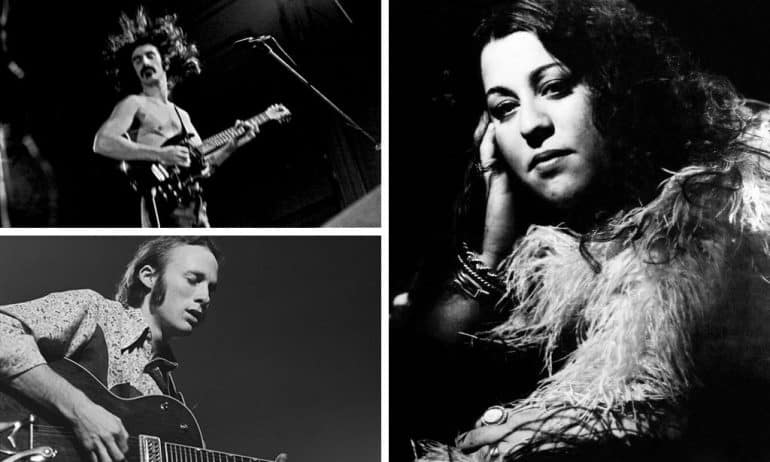Myrtle Anderson was visiting Los Angeles to see her daughter, Joni Mitchell. It was the late 1960s and Mitchell owned a house nestled in Los Angeles’ Laurel Canyon. The smell of eucalyptus was in the air and there was a soft warmth from the sun above.
From her dining room, where Mitchell’s mum was enjoying the hilled view, you could see Frank Zappa’s duck pond in his backyard. Three girls, stark naked, were floating around the pond on a raft. “My mother was horrified by my neighbourhood,” Mitchell recalled.
Frank Zappa had moved to the corner of Lookout Mountain and Laurel Canyon Boulevard during the recording of his debut record, Freak Out, in March 1966 with his friend Pamela Zarubica. Zappa was ultimately driven out of this house as it became the meeting (and living) place for various L.A. musicians and their entourage of groupies, despite Zappa’s disapproval of their drug use.
Key Takeaways
- Laurel Canyon in the late 1960s was a thriving hub for musicians and counterculture icons.
- The area was home to legendary musicians such as Joni Mitchell, Neil Young, David Crosby, and more.
- Laurel Canyon’s proximity to the Sunset Strip made it an ideal location for musicians seeking inspiration and collaboration.
- The formation of Crosby, Stills & Nash is attributed to connections made in Laurel Canyon.
- The area’s natural beauty and California weather added to its allure for musicians.
- Laurel Canyon’s musical legacy continues to inspire artists today.
The Laurel Canyon History
Sure, Los Angeles was already making a name for itself on the musical circuit, but it was in the 1960s that the creative exploration would accelerate. A revolution took hold of America. One of the early clubs to feature rock and roll on the Sunset Strip was Sea Witch.
Pandora’s Box, which had started as a 1950s jazz bar, became the home for new forward-thinking sounds. In October 1962, The Beach Boys held a residency at Pandora’s Box, sparking a new hangout for the dirty feet teens replacing the slick movie stars that once frequented the strip.
Then the Whisky-A-Go-Go appeared, changing L.A forever. Ciro’s opened up and The Byrds became the house band as their debut single, a cover of Dylan’s “Mr. Tambourine Man,” was making the rounds. Queues of desperate teenagers stringed down the street outside, everyone eager to get in.
The birth of The Byrds was possibly the most notable moment that put Los Angeles on a map for 1960s counterculture. Meandering down the steep drives of Laurel Canyon, past the hippies with their thumbs out and David Crosby standing on the porch of the Canyon Country Store in his cape and flat wide-brimmed hat, something that was a familiar sight for Glenn Frey, you’d eventually end up on the sunset strip.
Embed from Getty ImagesThe Legends at Laurel Canyon Neighborhood
What made Laurel Canyon so desirable was its close proximity to the happening area whilst being secluded in California wildness.
Sun seeking musicians from near and afar flocked to Laurel Canyon and soon it was the home to Joni Mitchell (known as the “Lady of the Canyon”), Neil Young, David Crosby, Stephen Stills, Graham Nash, Chris Hillman, Roger McGuinn, The Mamas and the Papas and more.
It was a melting pot of musicians from around the country. Mitchell and Young from Canada, Glenn Frey from Detroit, Stills from Texas and Linda Ronstadt from Arizona. The Mamas and the Papas had relocated from New York for an audition with Lou Adler, the co-founder of Dunhill Records. Stateside, the music business was moving from New York.
During the height of the British Invasion, with The Beatles, Stones and The Who all taking over the minds of American youth with their rock and roll and cups of tea, Laurel Canyon was blossoming with melodies and harmonies.
The nature surrounding the canyon was a drawing point for the musicians wanting to call it home. The hills were home to an abundance of wildlife with trails going for miles, the smell of wildflowers was permanently in the air and the California weather has been an inspiration for songwriters for years.
Embed from Getty Images“There was just something in the air up there,” tells Glenn Frey, a founding member of The Eagles, who moved to Laurel Canyon from Detroit. “There’s houses built up on stilts on the hillside and there’s palm trees and yuccas and eucalyptus and vegetation I’d never seen before in my life. It was a little magical hillside canyon.”
The souls that clung onto the hillside landscape have stories to tell, many of which will likely contradict thanks to them being stoned all of the time. One of these stories is the formation of Crosby, Stills & Nash, the greatest supergroup of all time, all of whom seem to have a different memory.
David Crosby was producing Joni Mitchell’s debut album in ’67 so was at Joni’s house a lot. He often brought Stephen Stills for the ride and they’d all go to Mama Cass Elliot’s house, the mother of the canyon.
Joni Mitchell takes responsibility for the formation of CSN; “I had met Graham Nash in Ottawa and then re-met him in California. David was producing my first album, and all these people were here. I do believe I introduced them at my house; that’s where Crosby, Stills & Nash was born.”
In contrary to this, Stills recalls talking to Cass at the Troubadour Club who told him that when Crosby invites him over to play guitar, just do it, don’t question it. This led to Stills’s story of the trio singing for the first time at Mama Cass’s house, though Graham Nash calls bullshit on that; “Stephen’s completely out of his mind,” he recalled. “I remember it clearly and so does David. It was not at Mama Cass’s. We did sing at Cass’s, but not the very first time.”
Embed from Getty ImagesThe one thing everyone does remember about the Canyon was that the vast majority of the musicians at home were writing in cycle – songs about loving each other, smoking with each other, living with each other or having sex with each other.
A leather-clad Jim Morrison was often seen in the Canyon when he wasn’t getting kicked out on his drunk ass from various bars. Morrison’s 1968 “Love Street” pays homage to the street in Laurel Canyon where he lived with his girlfriend Pamela Courson, and the Canyon Country Store as “the store where the creatures meet.”
Whilst Joni Mitchell’s 1970 record Ladies of the Canyon sings of her friends and neighbors and John Mayall sings about home in 1968’s album Blues from Laurel Canyon.
The sounds were rich and incomparable, and to this day inspire artists around the world. Here’s a good way to get started with Laurel Canyon music…
Frank Zappa – “Peaches En Regalia”
Linda Ronstadt – “You’re No Good”
The Doors – “Love Street“
Joni Mitchell – “Ladies of the Canyon”
Gram Parsons – “She”
The Mamas & the Papas – “Go Where You Wanna Go”
Frequently Asked Questions
Q1: What is Laurel Canyon known for?
From The Doors to Joni Mitchell and Frank Zappa, Laurel Canyon has been a haven for some of the greatest musical icons of the counterculture era. This picturesque canyon in Los Angeles was an integral part of the flourishing creative landscape of the 60s and 70s, inspiring countless timeless classics.
Q2: Do any stars still live in Laurel Canyon?
Yes – in fact, the valley’s lush surrounds and artistic legacy continue to charm some of Hollywood’s most celebrated names. From musicians to actors and artists, you can find them all tucked away in this picturesque oasis, enjoying its peaceful, secluded atmosphere, and artistic legacy.
Q3: Is Laurel Canyon worth visiting?
Absolutely! Laurel Canyon offers a unique blend of natural beauty, cultural significance, and a relaxed, bohemian atmosphere. Visitors can enjoy exploring the winding roads, lush greenery, and historic landmarks associated with the canyon’s musical heritage. As you stroll through this bohemian paradise, you might even catch a glimpse of some famous residents who call Hollywood Hills their home
Q4: Is Laurel Canyon open today?
Yes, Laurel Canyon is accessible for visitors to explore and enjoy. The roads and residential areas are generally open to the public, allowing one to experience the charm and history of the area firsthand.
Q5: What is a Laurel Canyon conspiracy?
The concept of the “Laurel Canyon conspiracy” is a theory that suggests that influential musicians of the 1960s and 70s were part of a clandestine governmental plot to control counterculture and shape social norms. These wild claims remain largely unproven, yet the intrigue surrounding them persists.
Written by Nathan McLaren-Stewart of Bad Luck Magazine.
Similar Stories…
- Michelle Phillips – Life in The Mamas & the Papas
- Mackenzie Phillips – Her Complete Harrowing Tale
- Elizabeth Shue – The Complete Story
- The Alice Cooper Fact Sheet – 5 Things You Need To Know - January 12, 2023
- Everybody Knows The Words, But What Is Hotel California About? - April 29, 2022
- What Is The Meaning Of Stairway To Heaven: Led Zeppelin’s Amazing 1971 Musical Epic? - April 24, 2022


